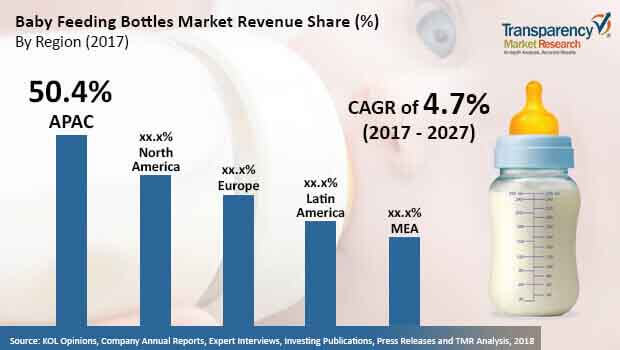
Generally, first-time parents often experience a dilemma concerning the choice of perfect baby feeding bottles. Conscious parents are buying baby feeding bottles after careful research and investigation of the quality of the product and the type of material used in the bottles. Components such as the nipple, cover, and collar of the bottle, and also the size of the neck of the bottle are being deeply scrutinized, and are impacting the buying decisions of consumers. Global revenue generated from baby feeding bottles market was around US$ 2,469.9 Mn by the end of 2017, which is expected to increase at a CAGR of 4.7% over the forecast period. Global baby feeding bottles market is expected to be valued at US$ 3,556.4 Mn by the end of 2025.

Drivers & Restraints:
Safe and convenient baby feeding bottles are occupying the most space on the shelves in the market. Most parents are also looking for durable baby feeding bottles. Usually, breastfeeding is preferred by parents and recommended by many doctors, but infant formula has to be fed through bottles, which is what is driving the growth of the baby feeding bottles market. Many brands and manufacturers offer baby feeding bottles with a variety of replaceable bottle parts, which can be used and replaced according to convenience. For example, the provision of various nipples, all with different rates of milk flow. Thus, a single product is applicable to infants, who need lesser milk or formula, and also to grown up babies who need to gulp down larger quantities of baby food.
Baby feeding bottles made out of polycarbonate are known to contain a harmful chemical called Bisphenol A (BPA). This BPA is a harmful chemical, and is known to mimic a hormone in the body which activates the progression of cancer and interferes with the development of the reproductive system. Due to its harmful nature, the usage of this chemical has been banned by many government bodies as far as baby feeding bottles are concerned. In recent times, even BPA-free polycarbonate has been found to be harmful for infants, which has led to mistrust amongst consumers towards the bottles made out of polycarbonate material. This factor has largely affected the segmental growth of the baby feeding bottles market within the recent past.
In 2017, the European Commission, which is an organization monitoring the proposals of European legislations, and implements decisions for the European parliament, extended its ban on BPA in baby feeding bottles to other products which come in contact with food and drinks, such as drinking cups and bottles. This signifies the potential of BPA as a harmful chemical in the body, and is also a strong restraint in the growth of polycarbonate baby feeding bottles.
Ask for brochure:
https://www.transparencymarketresearch.com/sample/sample.php?flag=B&rep_id=41537
Manufacturers are increasingly focusing on offering innovative products which make bottle feeding an enjoyable and easy experience. Products with extra features and which offer optimal safety to babies are becoming increasingly important for manufacturers to cater to consumer demand, and drive the growth of the baby feeding bottles market. A product design which saves the pain of cleaning and washing the bottle frequently, and which is easier to wash also captures the minds of consumers while buying baby feeding bottles. Other user-friendly features such as excellent venting system for the bottles tend to prevent the entrance and mixing of air bubbles in the baby food.
Read our latest Press Release:





